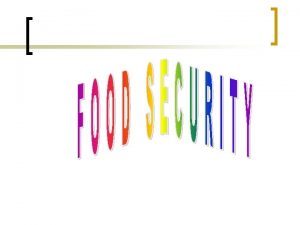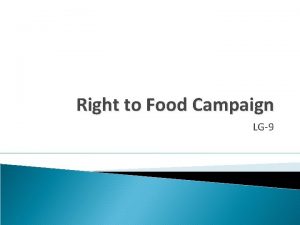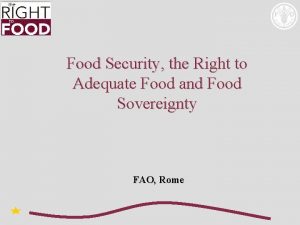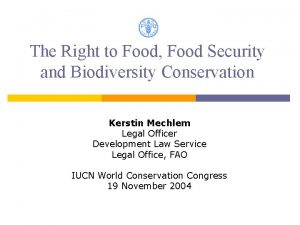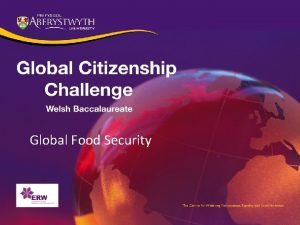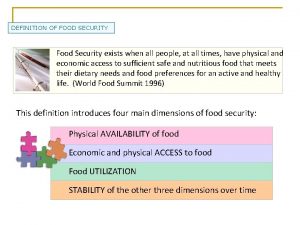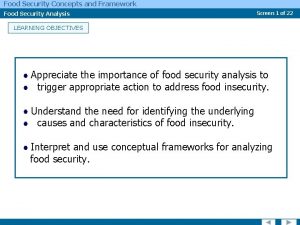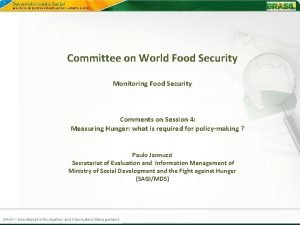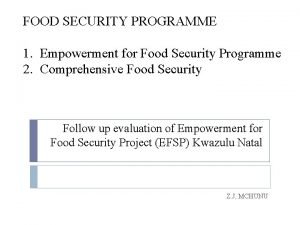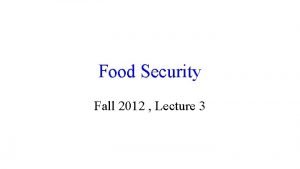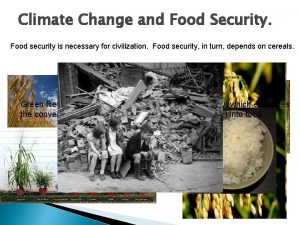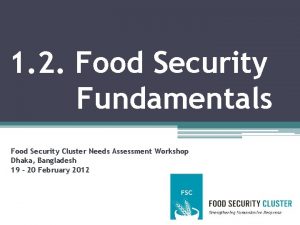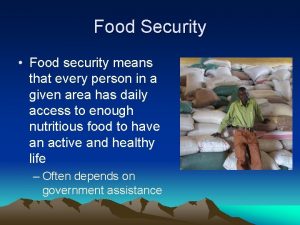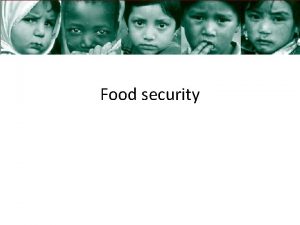Food security Food as a right The Right




















- Slides: 20

Food security

Food as a right The Right to Food is inscribed in the Universal Declaration on Human Rights (Article 25) and in the International Covenant on Economic, Social and Cultural Rights (Article 11).

Food security exists when all people, at all times, have physical, social and economic access to sufficient, safe and nutritious food to meet their dietary needs and food preferences for an active and healthy life (FAO). There are two types of food insecurity: chronic (similar to undernourishment and related to poverty) and transitory (resulting from temporary circumstances) How many people are • Hungry? 925 million • Overweight? 1 billion • Obese? 300 million

Isn’t there enough food to feed everyone? Yes there is enough food to ensure everyone is food secure, but… • A third of the world’s grain production is fed to animals. • The world’s hungry are outnumbered by those classified as overweight. • The total quantity of food and drink disposed to the sewer by UK households is estimated to be 1. 8 million tonnes (25% of food bought by households), costing consumers £ 2. 7 billion each year (WRAP). Guess how many of each of these products is thrown away every day in the UK…. 5. 1 million 4. 4 million 1. 6 million 2. 8 million

Two factors affect a person’s food security. Can you guess what they are? Availability of food of the correct quantity and quality Access to obtain and consume the available food

What factors influence food availability?

What factors influence food access?

How does food security relate to MDG 7 – ensure environmental sustainability? • The wildlife – rich forests of Indonesia and Malaysia are being chain-sawed to make way for Palm Oil plantations. • Thirty square miles are felled daily in a burst of habitat destruction that is taking place on a scale and speed almost unimaginable in the West. • When the rainforests disappear almost all of the wildlife – including the orang-utans, tigers, sun bears, bearded pigs and other endangered species – and indigenous people go. The species are indirectly killed by planting Palm Oil or directly killed if they destroy or eat the Palm Oil seeds. • In their place come palm-oil plantations stretching for mile after mile, producing cheap oil. What food products use palm oil? • Main use is in frying/cooking oils and fats • Margarine and spreads • Confectionary fats • Coffee creamers and imitation dairy products

How does food security relate to MDG 8 – develop a global partnership for development? • The 2009 G 8 summit in Italy unveiled the L’Aquila Food Security Initiative which promises $20 billion for poor countries spread over three years. The funding is intended to support national action plans on hunger, framed within a coherent global strategy for food security. This strategy is the responsibility of the Committee on Food Security (CFS) which pools the views of UN food agencies, civil society, donors and industry. • However, international aid for rural development, a vital part of the food security problem, has decreased substantially. • The actual funding required to achieve the hunger-related MDG by 2015 has been estimated by development agencies at up to $40 billion per annum. By comparison, according to the IMF, western governments mobilised $2, 500 billion to rescue their ruined banks. • Establishing an open trading system is part of MDG 8 which involves producing the products in which you have a competitive advantage. Look at the example of Cambodia to decide if this is a good model for food production…

refs • Food files 2007 • WRAP 'Down the Drain' 2009. • UN ‘water in changing world’ • (UN’s MDG Gap Task Force)

Price • • Despite the fact that the majority of food is grown in rural areas, most of the rural poor are net food buyers, not sellers, in many countries. Fluctuating prices of food have a huge effect on the poor in developing countries where up to 70% of income is spent on food. To cope with price rises people must reduce volume or nutritional quality of the food they consume. When the FAO Cereal Price Index doubled in the year to April 2008, food security became a global crisis. In Vietnam the price of rice rose 100% in 48 hours. The crisis temporarily pushed the global hunger count above one billion and led to food riots in 23 countries. Food prices are closely related to the price of oil due to oil-based fertilisers (which have contributed to increased yields over the years) and transport costs. The price of oil is expected to continue on an upward trend.

Population increase • There is an increased demand for food as the world population has increased. The world population is expected to reach 9 billion by 2050. • Higher wages also lead to changing dietary habits as people can afford to consume more meat (which uses more land to grow) and imported foods. In 2002, how many kilograms of meat were consumed person in: Denmark? 145. 9 Latvia? 45. 7 Bhutan? 3

World Trade Subsidies • The agricultural subsidies given by the US and the EU to their farmers reduce the price of their exported goods. This means agricultural goods in the Global South become comparatively more expensive, damaging their competitive advantage in agricultural exports and hence impacting on livelihoods. How much did the rich OECD countries pay for agricultural subsidies in 2008? $376 billion - nearly ten times the annual cost of eradicating hunger by 2025 Africa’s share of global trade in agriculture was 15% in the 1960 s (before the shift to neoliberalism). What was it by 2006? 3. 2% Dumping • While food aid is sometimes necessary, developed countries which ‘dump’ their surplus food on developing countries as free, subsidized, or cheap food (i. e. below market prices) undercut local farmers who cannot compete, and are driven out of jobs. Free market neo-liberalism • Developing countries have been forced to abolish supports to small farmers and open their markets to cheap imports over the last few decades. Structural adjustment programmes have undermined food security policies as government spending power has been reduced. Policies related to generating jobs and rules to protect fair wages and labour rights have been weakened by de-regulation. Public policies such as rural extension, price guarantees, rural credit, trade protection, agricultural research, strategic grain reserves and competition (anti-trust) rules are either under-resourced or disappear altogether. This means poor countries can no longer grow enough to feed their populations, and their farmers struggle to feed even their own families (action aid).

Gender and Age • • Cultural practices in many societies, especially in South Asia and Africa, mean that when food is scarce women and children are the last to eat, and their portions are the first to be reduced. In countries where women, and in particular widows, have no rights to own land they are unable to produce food for their families. • It has been shown that when women, as opposed to men, have control over household budgets, food and nutrition become a greater priority.

Conflict • • • Conflict reduces the number of people available to work on land, leads to deliberate or accidental destruction of crops, and causes migration which reduces income and ability to produce crops. Prolonged conflicts have cost Africa US$120 billion worth of lost agricultural production during the last third of the 20 th century. It is no coincidence that the two countries of most concern to hunger agencies are Afghanistan and the Democratic Republic of Congo. What percentage of the world’s use of fresh water that is globally extracted for human use does farming account for? 70% How many countries have already been involved in ‘water wars’? More than 30

• • • Loss of agricultural land Biofuels – Land is being used to produce biofuels instead of food, causing one third of the 2007/08 rise in food prices according to the IMF. – Filling the petrol tank of an average car with biofuel uses as much maize as an African person consumes in a year. – Both US and the European Union have ambitious long term targets for the use of biofuels. Both provide vast subsidies - in 2009 these totalled $9. 8 billion, more than the amount of foreign aid available for food security in developing countries. – In 2010 38% of the US grain crop was earmarked for ethanol, enough to feed over 400 million people for a year. Environmental Degradation and over exploitation – The ‘Green Revolution’ promoted the use of chemical fertilisers and pesticides, mechanisation and monocropping to increase productivity. This has lead to widespread environmental damage (erosion, water contamination by pesticides, biodiversity loss). – Generally this model has been implemented in large farms, encouraged by public policies and corporations. the spread of industrial agriculture has concentrated land, increased corporate control, and undermined farmers’ access to and control over water and seeds. Land grabbing – In many countries, land is extremely concentrated in the hands of few landlords and companies. In others, a similar land concentration process is beginning. Poor farmers are either excluded from land or forced to marginal areas with worse infrastructure, soil fertility or water access. – Governments are failing to promote equitable and just land reforms. The World Bank’s market approach to land reform has worsened the situation. – Some major food importers, such as the Gulf States and South Korea, have lost confidence in the market and are negotiating the purchase of extensive farmland in developing countries in order to secure food supplies. Which country owns a cattle ranch in Australia that is greater in area than its own country? Brunei is 5271 km². It’s ranch in Australia is 5, 859 km².

Climate Change Climate change will affect different areas differently in terms of agriculture. It is predicted that developing countries, who are least responsible for greenhouse gas emissions, will have the most severely affected food production. On the other hand, a warmer climate is likely to improve food production in temperate areas where the rich countries are. There is particular concern in sub. Saharan Africa where higher temperatures will shorten the growing seasons of staple crops and where poverty limits people’s capacity to adapt. iefworld. org

Trans National Corporations • The ability of poor people to access and control land, seeds, pastures, forests and water is crucial to combat hunger and food insecurity. But there is an increasing trend toward privatizing such resources and means in developing countries. • Intellectual property rights (IPR) systems that provide monopoly privileges over what was once common property are being promoted in international and national arenas. Such rights facilitate control by a few over genetic material and life forms such as seeds and livestock breeds. Intellectual property rights are predominantly owned by a single company, Monsanto. Should a small number of people be allowed to have such huge control over the entire world food production system? • While GM crops can boast higher yields, fewer chemical inputs, higher nutritional content and resilience to extreme weather, GM depends on capital intensive farming and is often unavailable to the poor as input costs are higher. Thus, GM crops are pushing small farmers out of the market.

Do natural disasters cause famine? While natural disasters such as flooding and drought can lead to destruction of crops this does not necessarily imply famine. Think about Australia…. Despite droughts in 2002, 2006, 2007, 2008 and 2009 there has been no famine in Australia What other factors contribute to famine? • Hoarding of food for speculation • Increased prices to make profit from shortages • Lack of government planning for relief e. g. maintenance of food reserves • Inadequate transport to the regions affected • Use as a political weapon e. g. to clear land of people in order to seize it, to punish opposition supporters

Neo-liberalism in Cambodia has followed a neoliberal path and concentrated on its competitive advantage – growing rice, and allowing Thailand to concentrate on its competitive advantage – milling and polishing rice. Can you guess why Cambodians struggle to feed themselves? Rice cannot be eaten without being milled and polished and so many Cambodian farmers, and all farm workers, actually buy food in the market rather than eat what they grow. This causes two problems. The first is that Cambodia is buying back rice it has already grown at a higher price than it sold it for. This is because milling and polishing adds value to the rice and increases its price. The second problem is that Cambodia has to pay the world market price for rice it grows. When the price of rice suddenly rises, as it has by 50% in the first six months of 2008, even rice farmers cannot afford to feed their families.
 Right product right place right time right price
Right product right place right time right price Right time right place right quantity right quality
Right time right place right quantity right quality Private securty
Private securty The right man on the right place at the right time
The right man on the right place at the right time Control measures for physical hazards
Control measures for physical hazards Hình ảnh bộ gõ cơ thể búng tay
Hình ảnh bộ gõ cơ thể búng tay Lp html
Lp html Bổ thể
Bổ thể Tỉ lệ cơ thể trẻ em
Tỉ lệ cơ thể trẻ em Voi kéo gỗ như thế nào
Voi kéo gỗ như thế nào Tư thế worm breton
Tư thế worm breton Chúa sống lại
Chúa sống lại Các môn thể thao bắt đầu bằng tiếng bóng
Các môn thể thao bắt đầu bằng tiếng bóng Thế nào là hệ số cao nhất
Thế nào là hệ số cao nhất Các châu lục và đại dương trên thế giới
Các châu lục và đại dương trên thế giới Công thức tính độ biến thiên đông lượng
Công thức tính độ biến thiên đông lượng Trời xanh đây là của chúng ta thể thơ
Trời xanh đây là của chúng ta thể thơ Cách giải mật thư tọa độ
Cách giải mật thư tọa độ Làm thế nào để 102-1=99
Làm thế nào để 102-1=99 độ dài liên kết
độ dài liên kết Các châu lục và đại dương trên thế giới
Các châu lục và đại dương trên thế giới





















